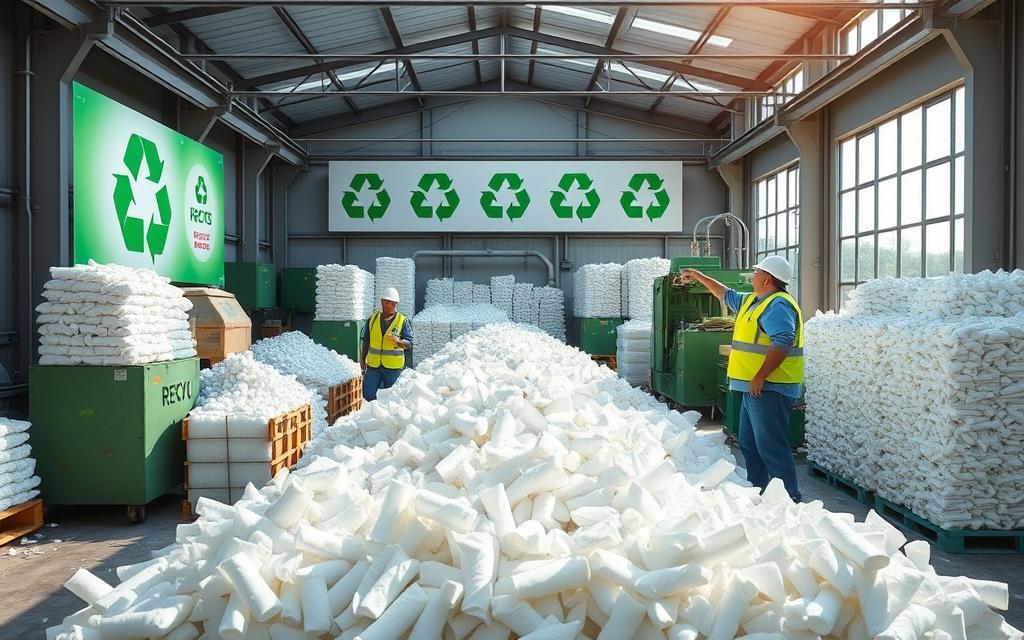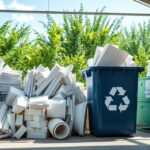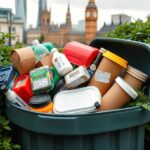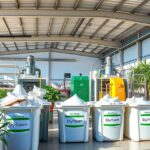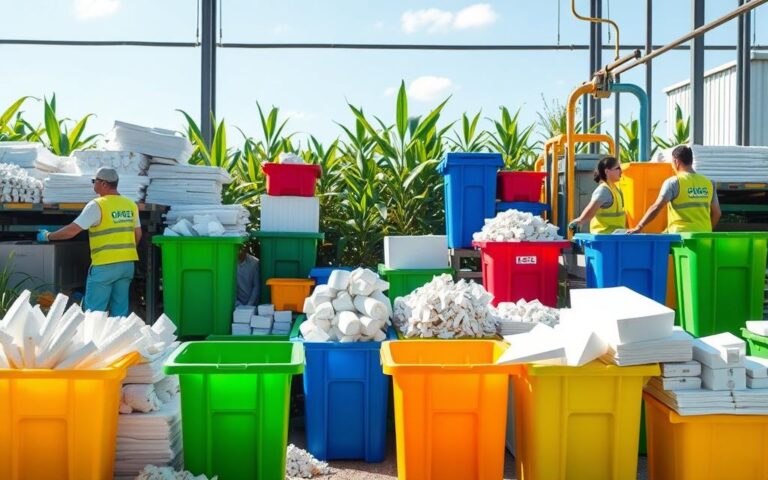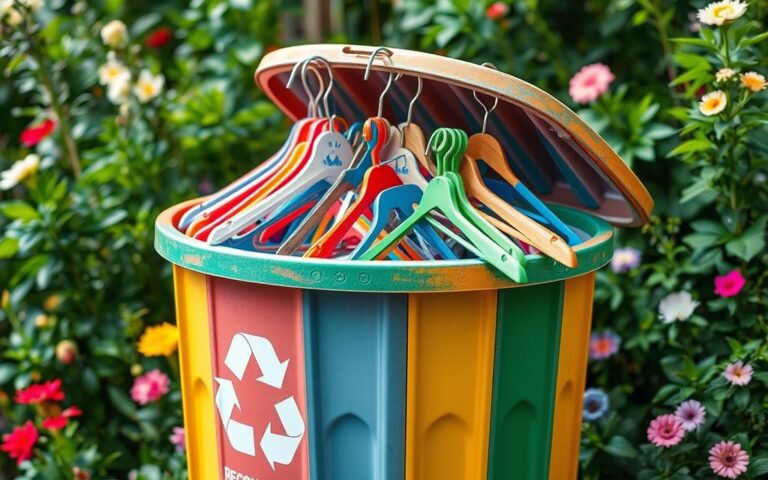Can Polystyrene Be Recycled in the UK? Green Disposal Guide
Polystyrene, also known as Styrofoam, is a common plastic. It is used in takeaway containers and protective packaging. But, its light and bulky nature makes recycling in the UK a challenge. This guide sheds light on how to recycle polystyrene and discusses eco-friendly disposal. It also talks about new recycling technologies. These advances make it easier to deal with polystyrene waste, helping us to better understand our recycling options.
Understanding recycling symbols and labels is vital. It allows consumers to lessen the negative effects of polystyrene on the environment. By backing efficient recycling efforts, communities can enhance their waste management. This is a step towards a sustainable future.
Understanding Polystyrene and Its Uses
Polystyrene is widely used in different industries. It’s made from styrene monomer and is found in forms like Expanded Polystyrene (EPS) and Extruded Polystyrene (XPS). Each form has special features leading to many uses in daily life. Knowing about these types and their uses helps us see their benefits and challenges.
What is Polystyrene?
Polystyrene comes in two main types. Expanded Polystyrene (EPS) is light, great for insulating, and resists moisture. It’s used in items like coffee cups, food containers, and packing materials. Extruded Polystyrene (XPS) is thicker and mostly insulates buildings. Both types are liked for being versatile and not too expensive, but recycling them is hard because they take a long time to break down.
Common Applications of Polystyrene
Polystyrene is used in many ways, such as:
- Food packaging like boxes and foam cups
- Egg cartons and disposable cutlery
- Construction insulation panels
- Toys and goods for consumers
These uses show how affordable and flexible the material is. Each year, about 15.6 million tons of polystyrene are made, with a lot of it turning into products for both businesses and homes.
Environmental Concerns
The impact of polystyrene on the environment is big and concerning. It makes up about 30% of what’s in landfills and 20% of general litter. It can take 500 years to break down, adding to pollution over time. It’s worrying that only 12% is recycled, though the UK does recycle over 100 tonnes of EPS each month. The ban on single-use plastics in England shows the push for better care for our planet.
To reduce polystyrene’s environmental harm, recycling partnerships are key. Partnerships like the one between DS Smith Recycling and Tesco, and the John Lewis Partnership’s scheme, show promise. New recycling tech gives us hope for better handling of EPS, which can be fully recycled. Tackling these environmental issues is vital for a sustainable future with polystyrene.
| Aspect | Fact |
|---|---|
| Annual Production | 15.6 million tons of polystyrene |
| Landfill Contribution | 30% of landfill waste is polystyrene |
| Litter Statistics | 20% of general litter is polystyrene |
| Recycling Rate | Only 12% of polystyrene is recycled |
| EPS Recycling | Over 100 tonnes of EPS recycled monthly in the UK |
| Environmental Lifespan | Polystyrene can take up to 500 years to decompose |
| Consumer Responsibility | 82% believe businesses should protect the environment |
Is Polystyrene Recyclable?
Can polystyrene be recycled? This question isn’t straightforward. It’s important to understand the challenges and the effort to improve its recyclability. There are effective methods and technological progress. Yet, obstacles remain.
Challenges in Recycling Polystyrene
Recycling polystyrene comes with hurdles. It’s bulky, making transport costly. This complicates collection and processing. For instance, Liverpool City Council struggles to collect it. This results in a low recycling rate, with only 1% of UK councils recycling polystyrene trays.
It’s tough to break polystyrene into smaller pieces. Knowing local recycling rules is crucial. Mistakes like placing polystyrene in curbside bins make matters worse.
Recent Advances in Recycling Technology
New technology offers hope. Methods such as granulation and densifying are making recycling easier. For example, Central Waste recycles 95% of materials they handle. John Lewis also has a take-back scheme for packaging.
Moreover, turning polystyrene back into its original form, through depolymerisation, supports a circular economy. It’s a promising future.
| Challenges in Recycling Polystyrene | Advancements in Recycling Technology |
|---|---|
| High transport costs | Granulation, compacting, and densifying methods |
| Limited council participation | High recycling rates at facilities like Central Waste |
| Low consumer awareness and access | Emerging depolymerisation technologies |
| Difficulty in breaking down material | Take-back schemes by retailers |
| Common disposal mistakes | Increased environmental awareness driving initiatives |
can polystyrene be recycled uk
In the UK, recycling polystyrene is possible but comes with challenges. Not all places have local recycling programs for it. While some councils pick up certain types of polystyrene, others don’t. This means, in many areas, people have to throw it in with regular trash.
Local Recycling Options and Programmes
Some UK councils now recycle EPS, but it’s not everywhere. It’s crucial to check with local authorities for UK recycling options. Raising awareness can help more of us keep polystyrene out of landfills.
Specialised Processing Facilities
The UK has special facilities that recycle polystyrene, making a big difference. Stores like B&Q are part of this movement. They provide places for people to drop off used polystyrene. A project in Swindon is even looking at advanced recycling methods.
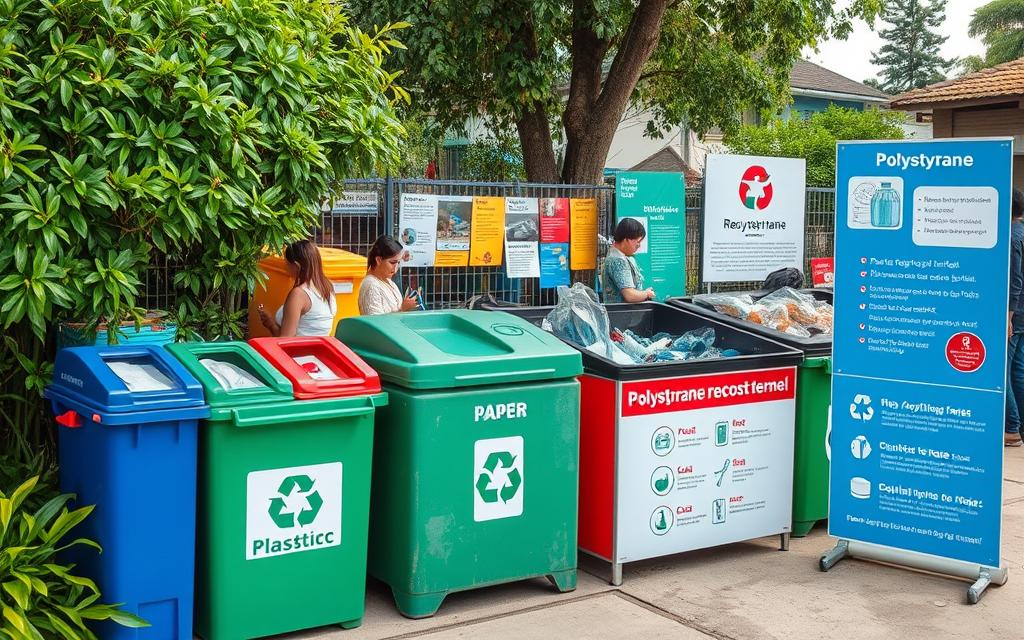
| Type of Polystyrene | Recyclability | Commonly Accepted In |
|---|---|---|
| Expanded Polystyrene (EPS) | Yes | Specific councils, retailers (B&Q) |
| Extruded Polystyrene (XPS) | Limited | Scattered local initiatives |
| Various Packaging Forms | No | General waste bins |
This table shows the recyclability of different polystyrene types. It tells us where they’re accepted. Understanding these options is key.
How to Properly Dispose of Polystyrene
It’s really important to get rid of polystyrene the right way. This helps lessen its bad effects on the environment. People should know the steps for recycling it and find the right services to take it away.
Steps for Effective Recycling
There are key steps to follow when recycling polystyrene:
- Find local recycling programmes that take in polystyrene. This helps you know what your area requires.
- Make sure the polystyrene is clean and free of food or other leftovers. These leftovers can mess up the recycling process.
- Get the polystyrene ready for pick-up or dropping it off. This makes it easier to recycle at the facility.
- Join in community efforts that push for more recycling of polystyrene. Getting involved locally helps increase recycling.
Drop-Off Points and Collection Services
There are easy drop-off spots for getting rid of polystyrene in many places. Using these spots ensures it’s disposed of correctly:
- Ask your local council where you can drop off polystyrene.
- Look out for services that collect polystyrene, run by companies that have a licence to do so. These services help make recycling smoother.
- Take part in local projects that aim to get better at recycling polystyrene in the area.
Benefits of Recycling Polystyrene
Recycling polystyrene offers many environmental and economic benefits. It helps businesses and individuals make better choices about waste. This practice supports the planet and our wallets.
Environmental Advantages
Recycling polystyrene reduces landfill waste and cuts down on pollution. In the UK, we recycle more than 100 tonnes of it each month. This action significantly lowers our carbon emissions.
Polystyrene waste is a major part of marine debris, making up to 90% of it. Recycling can protect our oceans and reduce harmful emissions from burning polystyrene.
Economic Opportunities
Recycling can create new ways for businesses to earn money. Companies might get up to £500 for each tonne of recycled polystyrene. This makes it an attractive option.
Using equipment like compactors can shrink polystyrene waste by 95%. This means lower costs for waste collection. phs Wastekit provides solutions that improve efficiency and increase earnings from recycling.
Supporting a Circular Economy
Encouraging the recycling of polystyrene promotes sustainability. Closed-loop systems show how we can recycle more effectively for the long term. By recycling, we use fewer new materials and reduce landfill waste.
This helps create a sustainable future for everyone. Recycling polystyrene plays a big part in this effort.
| Aspect | Details |
|---|---|
| Landfill Waste Reduction | Monthly recycling of 100 tonnes of EPS helps divert waste from landfills. |
| Potential Revenue | Companies may earn up to £500 per tonne for recycled polystyrene. |
| Environmental Protection | Recycling prevents marine debris, reducing threats to aquatic life. |
| Operational Efficiency | Polystyrene compactors can reduce size by 95%, saving space and costs. |
| Carbon Footprint | Extending the lifecycle of materials reduces overall carbon emissions. |
Conclusion
Understanding how to dispose of polystyrene sustainably in the UK is vital. This durable plastic can last in landfills for over 500 years. So, it’s crucial we act now to recycle it. New recycling methods, like compressing Expanded Polystyrene (EPS), show hope for better recycling rates and less environmental harm.
It’s important for everyone to take part in local recycling schemes. These often have special spots for dropping off polystyrene, since you can’t put it in regular rubbish bins. Checking with your local council for the right way to recycle helps make sure it’s done correctly. Getting creative with reusing polystyrene in gardens or for art projects can also lead to a cleaner planet.
Improving recycling means everyone working together and understanding the impact on the environment. Cutting down on how much polystyrene we use helps reduce waste. By following these steps, we can face the challenge of polystyrene head on. This can lead us to a sustainable future. For more tips, check out the polystyrene recycling guidelines.
FAQ
What types of polystyrene are there?
We mainly see two types of polystyrene. Expanded Polystyrene (EPS) is common in takeaway containers and coffee cups. Extruded Polystyrene (XPS) is often found insulating buildings. Both are moisture-resistant but hard to recycle.
How long does polystyrene take to decompose?
It can linger for up to 500 years in landfills, causing pollution. This highlights the need for better recycling and disposal ways.
Is polystyrene recyclable in the UK?
Technically, yes, polystyrene can be recycled. But, its bulky nature and the need for special sites complicate matters. Your local council’s guidelines will tell you more about your area’s options.
What are the main challenges associated with polystyrene recycling?
Its challenges include being light and bulky. It’s hard to recycle because it breaks easily and can get dirty with food. We need better infrastructure to recycle it properly.
What advancements are being made in polystyrene recycling technology?
Innovative steps include depolymerisation, which breaks polystyrene down for reuse. Additionally, other methods convert it into useful chemicals. These advances boost its recycling potential.
Where can I find local polystyrene recycling programmes?
Recycling options differ across the UK. Some places have dedicated spots for EPS and XPS. Others may not. Always check with your local council for their advice.
Are there any facilities that specialise in processing polystyrene?
Yes. There are special recycling centres. Also, stores like B&Q offer drop-off points for polystyrene. This makes recycling easier.
What steps can I take to recycle polystyrene effectively?
Look for local recycling schemes that take polystyrene. Make sure to clean it of any food or dirt. This helps make recycling successful.
What are the environmental benefits of recycling polystyrene?
Recycling it cuts down on landfill use and pollution. Reprocessing helps lower carbon emissions. It’s a step towards lessening environmental damage.
How does recycling polystyrene create economic opportunities?
New recycling tech can create economic chances by turning waste into valuable products. This not only tackles waste management but also lessens new material need.
How can recycling polystyrene support a circular economy?
It encourages reusing resources, aiming for sustainability. Systems like innovative depolymerisation plants can sustainably recycle, supporting a circular economy.

